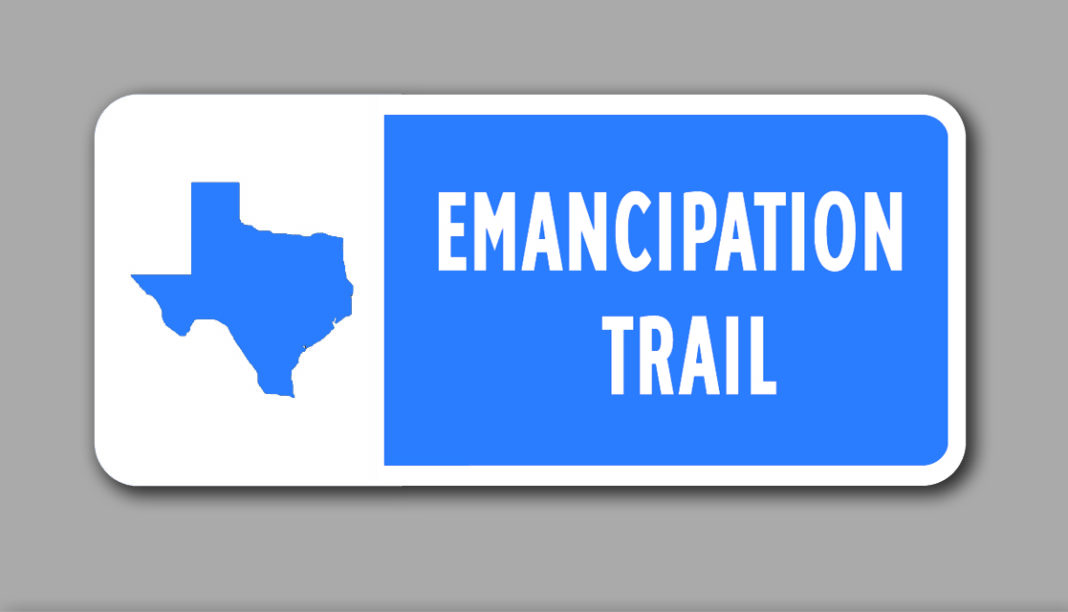
On September 22, 1862, President Abraham Lincoln signed the Emancipation Proclamation. When it was issued on January 1, 1863, it effectively abolished slavery, freeing over three million enslaved African Americans. Sadly, word of it reached Texas nearly two years later, when General Gordon Granger read “General Order No. 3” aloud publicly in the port city Galveston on June 19, 1865.
The anniversary of this day quickly became known as “Juneteenth” for African Americans throughout Texas. Celebrating the new holiday was difficult in cities like nearby, segregated Houston, where no parks allowed African Americans to congregate. In 1872, Houston clergyman Reverend Jack Yates led a fundraising effort to buy ten acres of land as a home for Juneteenth celebrations, naming the site Emancipation Park.

In late 2019, U.S. Rep. Sheila Jackson Lee (D) and U.S. Sen. John Cornyn (R) authored a bill for a federal study of the Emancipation Trail, a proposed 51-mile route from Galveston to Houston. The path would mark the journey by black families sharing the news that all of the enslaved people of Texas were freed. And like the existing Selma-to-Montgomery National Historic Trail, this new route would highlight historic landmarks from Galveston to Houston, including the former Osterman Building in Galveston, where Maj. Gen. Gordon Granger issued General Order No. 3 in 1865, the Reedy Chapel African American Methodist church, the 1867 settlement in Texas City, the Butler Longhorn Museum in League City, Olivewood Cemetery, the African American Library at the Gregory School in Houston’s historic Freedmen’s Town, the Rev. Ned Pullum and Emma Eddy Pullum House, Antioch Missionary Baptist Church, and ending at Emancipation Park.
“This Emancipation Trail will become only the second in the history of the United States to commemorate the history of African Americans. It will provide enhanced knowledge about the historic announcement by Captain Granger that the slaves were free. I am excited that we were able to secure this legislation in a very short period of time which now establishes the first historic trail solely within the boundaries of the State of Texas. This will be a great asset for the citizens of the State of Texas and I am delighted to have introduced this bill in the House and very pleased that Senator Cornyn joined me by introducing it in the Senate.” — Rep. Jackson Lee
Osterman Building
Following the end of the Civil War, Union troops arrived in Galveston. Maj. Gen. Gordon Granger read the order publicly from their headquarters in the Osterman building, now in the historic district known as The Strand.
“The people of Texas are informed that, in accordance with a proclamation from the Executive of the United States, all slaves are free. This involves an absolute equality of personal rights and rights of property between former masters and slaves, and the connection heretofore existing between them becomes that between employer and hired labor. The freedmen are advised to remain quietly at their present homes and work for wages. They are informed that they will not be allowed to collect at military posts and that they will not be supported in idleness either there or elsewhere.” — General Gordon Granger, General Order No. 3”
The Reedy Chapel African Methodist Episcopal Church
In 1848, the Methodist Episcopal Church South established this African American church, and in 1866 the church was deeded to newly freed slaves, becoming the first African Methodist Episcopal Church in Texas. Later named in honor of its first pastor the Rev. Houston Reedy of Philadelphia, Pennsylvania. It also holds the distinction of surviving the hurricane of 1900.
Freedmen’s Town
This African American community in Houston’s Fourth Ward was settled by freed slaves in the late 1860s. A former thriving neighborhood of twenty-eight blocks with more than four hundred black-owned businesses, it slowly lost its distinctiveness and strength when projects such as the whites-only San Felipe Courts were built by the city’s Housing Authority on one-quarter of taken land, or when the Pierce Elevated freeway cut through its eastern border. Following desegregation, the African American community itself left for better neighborhoods, leaving older renters behind. In 1976, the National Park Service recognized forty blocks as a National Historic District, but with little implied protection. In 2009, the Houston Public Library opened the African American Library at the Gregory School, and Houston Independent School District opened the Carnegie Vanguard High School in 2012. Freedmen’s Town was once commonly known as “the Mother Ward” and “Houston’s Harlem.”
Emancipation Park
The City of Houston acquired it in 1916, and in a racially segregated city, Emancipation Park was the only municipal park African Americans could use. In 1939, the Works Progress Administration built a community center building, swimming pool, and bathhouse in Emancipation Park. Suffering from years of inconsistent support, Emancipation Park developed a plan for redevelopment with support from local public and private groups. The comprehensive $35 million upgrades included a new recreation center, renovation of the existing community center and bathhouse, a new swimming pool, reconfigured parking, a playground, a walking trail, tennis and basketball courts, and a ball field.

